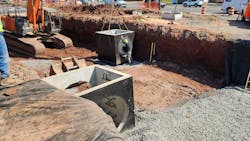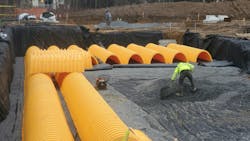Detecting underground detention systems
Stormwater management systems are increasingly becoming a normal requirement for new construction projects, including both residential and commercial properties. In many areas, such as urban sites, site limitations and constraints dictate the need for an underground detention system.
Underground detention systems take a variety of forms. These may be storage vaults, gravel beds, perforated pipes, and storm chambers, which are designed to either mitigate overflow by taking surface runoff and temporary storing in increase capacity or provide runoff infiltration meant to slowly seep into the soil. The design of these systems covers a broad range of criteria including control of discharge, ground water levels, soil contamination and maintenance. Yet one question remains: how do we find these systems once they are built?
Finding underground detention systems post installation is a growing concern for subsurface utility locators. Too often there are not enough indicators on the ground to prompt anyone of its underground presence, and this can lead to excavators striking the system and rendering it useless. Underground detention systems that are hit or damaged, may require extensive excavation and cost to return the system to normal operations. This is a cost that may be ultimately borne by the property owner.
Detecting underground detention systems
Currently, there are no effective methods to locate underground detention systems. The methods and technologies used for other utilities and subsurface features are limited in use when trying to locate the components that make up a detention system. Some of the issues encountered include:
No Records
When utility locators come onto a site, seldom are records available showing that an underground detention system is in place, let alone its location and design.
Difficult to Detect
Underground detention systems are typically buried at depths of 5-6 feet or greater. Most systems are non-metallic, which limits their detection to ground penetrating radar (GPR). GPR is greatly affected by soil, site conditions and the materials used to build the detention system. All of which greatly reduces the effectiveness of the GPR equipment.
Design Changes
Systems may not be built as designed due to unrecorded design changes and changes due to site conditions may result in a final system different from what was originally planned.
As a result, underground detention systems are extremely difficult to detect, locate and map for property owners and stakeholders.
How to better detect the systems
There are solutions to these problems, and it involves using existing technology that is readily available to the utility locating industry.
Tracer wires
Tracer wires have been a time-tested solution for providing a means locate buried, non-metallic lines. A tracer wire is placed with the utility line during construction and provides a means for locating the line easily and accurately. For an underground detention system, a tracer wire can be placed around the perimeter of the system and approximately 1 foot below grade. The wire loops around the system and comes up into one of the inspection ports or manholes. A utility locate technician can connect to the wire and is able to apply a tone to it, and then trace out the perimeter of the detention system footprint.
Marker balls and pins
Marker Balls/Pins are another solid solution. Using RFID technology set to a specific frequency. These can be placed around the perimeter of the detention system at regular intervals, this would typically be 10-20 feet. The markers form a “bread crumb” trail around the detention basin. These markers are also available with chips that can be programmed to include information about installation data, manufacturer, system type, pipe size, or pipe material.
Built drawings
As built drawings are another key component of ensuring the protection of the underground detention system. These should be based upon the system as built in the field, and not from design drawings. In addition to aiding the location of the detention system, they provide the owner with documented proof of the system as it was constructed for review by regulatory agencies.
Conclusion
There currently is no standard for making underground detention systems detectable. As stormwater management and underground detention systems continue to evolve and improve, the best practices involved with their documentation and construction to ensure their future location and protection should evolve as well.
About the Author
Morgan Abele
Morgan Abele is Vice President of Operations for Shaheed A Smith Geospatial, LLC. He has been involved in the location and protection of underground utility systems and infrastructure for 40-years.



